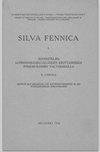Longitudinal differences in Scots pine shoot elongation
IF 1.7
3区 农林科学
Q2 FORESTRY
引用次数: 7
Abstract
Phenology can have a profound effect on growth and climatic adaptability of long-lived, northern tree species such as Scots pine (Pinus sylvestris L.), where the onset of growth in the spring is triggered mainly by accumulated heat, while cessation of growth is related to the joint effect of photoperiod and temperature. In this study, the objectives were: (1) to compare shoot phenology of genetic material from Scandinavia (maritime climate origin) and northern Russia (continental climate origin) sources, under field conditions in both Scandinavia and Russia (maritime and continental growth conditions); and (2) to estimate the heritabilities of phenological parameters. The material used was part of a larger provenance test series involving Scots pine populations and open-pollinated plus-tree families from Russia, Sweden and Finland. Terminal shoot elongation was measured on multiple occasions during the seventh growing season from seed at a trial near Bäcksjön (Sweden) and Syktyvkar (northern Russia). We calculated the regression of relative shoot elongation over accumulated heat sum above +5 °C using an exponential expression. Seedlings of Swedish and Russian provenance had similar heat-sum requirements for growth onset and cessation in both trials. More northern provenances started onset and cessation at a lower temperature sum, but heat accumulation requirements for onset were not fixed. Scots pine may suffer from spring frost due to earlier growth onset in a warming climate. Variation and heritability of phenological traits show potential to adapt Scots pine to new climate conditions by breeding.苏格兰松梢伸长的纵向差异
物候学可以对长寿的北方树种的生长和气候适应性产生深远的影响,如苏格兰松(Pinus sylvestris L.),其春季生长的开始主要由积热触发,而生长的停止则与光周期和温度的联合作用有关。本研究的目的是:(1)在斯堪的纳维亚和俄罗斯(海洋和大陆生长条件)的野外条件下,比较斯堪的纳维亚(海洋性气候来源)和俄罗斯北部(大陆性气候来源)的遗传物质的物候特征;(2)估算物候参数的遗传力。所使用的材料是一个更大的来源测试系列的一部分,涉及苏格兰松种群和来自俄罗斯、瑞典和芬兰的开放式授粉加树家族。在瑞典Bäcksjön和俄罗斯北部Syktyvkar附近的一个试验中,在第七生长季从种子开始多次测量了顶芽伸长。我们使用指数表达式计算了相对茎伸长在+5°C以上累积热量总和的回归。在两个试验中,瑞典和俄罗斯种源的幼苗在生长开始和停止时具有相似的热和需求。更多的北方种源在较低的温度总和下开始发病和停止,但发病的热积累要求并不固定。由于气候变暖,苏格兰松生长较早,因此可能遭受春季霜冻。物候性状的变异和遗传力显示了通过育种使苏格兰松适应新气候条件的潜力。
本文章由计算机程序翻译,如有差异,请以英文原文为准。
求助全文
约1分钟内获得全文
求助全文
来源期刊

Silva Fennica
农林科学-林学
CiteScore
3.50
自引率
11.10%
发文量
21
审稿时长
3 months
期刊介绍:
Silva Fennica publishes significant new knowledge on forest sciences. The scope covers research on forestry and forest ecosystems. Silva Fennica aims to increase understanding on forest ecosystems, and sustainable use and conservation of forest resources. Use of forest resources includes all aspects of forestry containing biomass-based and non-timber products, economic and social factors etc.
 求助内容:
求助内容: 应助结果提醒方式:
应助结果提醒方式:


